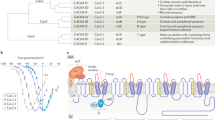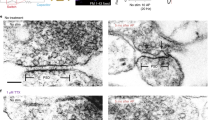Abstract
THERE are two hypotheses to explain how neurons release transmitter. The calcium hypothesis proposes that membrane depolarization is necessary only for opening calcium channels and increasing internal calcium concentration ([Ca2+]i) near membrane transmitter-release sites1–3. These calcium ions trigger a transient release of neurotransmitter4,5. The calcium-voltage hypothesis postulates that voltage induces a conformational change in a membrane protein rendering it sensitive to calcium such that, in the presence of high [Ca2+]i depolarization directly triggers transmitter release6–9. Here we report that when calcium influx is blocked by cobalt or manganese ions in a calcium-free Ringer, as measured with Fura-2, and [Ca2+]i is elevated by liberation from a caged calcium compound, transmitter release at the crayfish neuromuscular junction is unaffected by presynaptic action potentials. These results support the calcium hypothesis.
This is a preview of subscription content, access via your institution
Access options
Subscribe to this journal
Receive 51 print issues and online access
$199.00 per year
only $3.90 per issue
Buy this article
- Purchase on Springer Link
- Instant access to full article PDF
Prices may be subject to local taxes which are calculated during checkout
Similar content being viewed by others
References
Zucker, R. S. & Landò, L. Science 231, 574–579 (1986).
Zucker, R. S. & Haydon, P. G. Nature 335, 360–362 (1988).
Zucker, R. S., Landò, L. & Fogelson, A. L. J. Physiol., Paris 81, 237–245 (1986).
Katz, B. The Release of Neural Transmitter Substances. (Thomas, Springfield, 1969).
Miledi, R. Proc. R. Soc. B183, 421–425 (1973).
Llinás, R., Steinberg, I. Z. & Walton, K. Biophys. J. 33, 323–352 (1981).
Dudel, J., Parnas, I. & Parnas, H. Pflügers Arch. 399, 1–10 (1983).
Parnas, I., Parnas, H. & Dudel, J. Pflügers Arch. 406, 121–130 (1986).
Parnas, I., Parnas, H. & Dudel, J. Pflügers Arch. 406, 131–137 (1986).
Hochner, B., Parnas, H. & Parnas, I. Nature 342, 433–435 (1989).
Zucker, R. S. A. Rev. Neurosci. 12, 13–31 (1989).
Kaplan, J. H. & Ellis-Davies, G. C. R. Proc. natn. Acad. Sci. U.S.A. 85, 6571–6575 (1988).
Delaney, K. R., Zucker, R. S. & Tank, D. W. J. Neurosci. 9, 3558–3567 (1989).
Narita, K., Kawasaki, F. & Kita, H. Brain Res. 510, 289–295 (1990).
Hallam, T. J., Jacob, R. & Merritt, J. E. Biochem. J. 255, 179–184 (1988).
Foder, B., Scharff, O. & Thastrup, O. Cell Calcium 10, 477–490 (1989).
Grynkiewicz, G., Poenie, M. & Tsien, R. Y. J. biol. Chem. 260, 3440–3450 (1985).
Fogelson, A. L. & Zucker, R. S. Biophys. J. 48, 1003–1017 (1985).
Delaney, K. R. & Zucker, R. S. J. Physiol. 426, 473–498 (1990).
Bittner, G. D., J. Neurobiol. 20, 386–408 (1988).
Author information
Authors and Affiliations
Rights and permissions
About this article
Cite this article
Mulkey, R., Zucker, R. Action potentials must admit calcium to evoke transmitter release. Nature 350, 153–155 (1991). https://doi.org/10.1038/350153a0
Received:
Accepted:
Issue Date:
DOI: https://doi.org/10.1038/350153a0
This article is cited by
-
Changes in the excitability of primary hippocampal neurons following exposure to 3.0 GHz radiofrequency electromagnetic fields
Scientific Reports (2022)
-
The endoplasmic reticulum: structure, function and response to cellular signaling
Cellular and Molecular Life Sciences (2016)
-
Voltage-gated sodium channel expression and action potential generation in differentiated NG108-15 cells
BMC Neuroscience (2012)
-
A dual-Ca2+-sensor model for neurotransmitter release in a central synapse
Nature (2007)
-
Release of Neurotransmitter Induced by Ca2+-Uncaging: Reexamination of the Ca-Voltage Hypothesis for Release
Journal of Computational Neuroscience (2005)
Comments
By submitting a comment you agree to abide by our Terms and Community Guidelines. If you find something abusive or that does not comply with our terms or guidelines please flag it as inappropriate.



